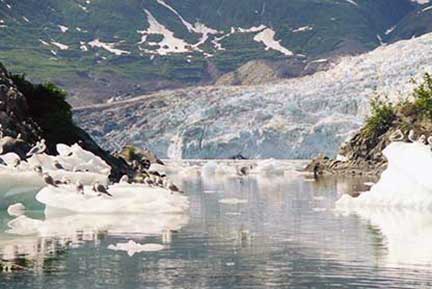 Prince William Sound 2001
Prince William Sound 2001
The first day of our three-week adventure was so clear and calm that we decided to fly the 100 miles from Whittier to Cordova in our Cessna 150. The flight was over a lot of open sea. We skirted the northern coast so we'd have options in case of emergency. The real destination was Katalla, the site of what might have become a major Alaskan city. Rich deposits of coal and oil were discovered there in 1901. The first oil well gushed 85' high and produced 1,600 barrels a day! Katalla was once called "The Pittsburgh of the North" but after its 2000' breakwater collapsed in a record-breaking winter storm, the location was gradually abandoned. Mineral wealth remains in the ground, guarded by towering mountains to the north and the vast Pacific Ocean to the south.
On the way back we landed on Hinchinbrook Island and hiked the outer coast, a place far too shallow and dangerous for us to visit by boat. Offshore waves from contrary currents smashed together into 100' waterspouts. I can't imagine what it would be like in a winter storm!
On our return to Whittier, we met friends with a 21' Bayliner similar to ours. We "buddy boated" across northern Prince William Sound to Valdez, then on to Cordova. As always, it was a taste of heaven. We treasure memories of canoing miles through icebergs in soft midnight twilight, listening to Pachelbel's Canon in D roll across silky water in a lonely cove, hiking in a deluge to the top of a raging cascade.
From Sheep Bay, Dennis and I explored up the river. I rounded a corner to find myself behind a grizzly traveling the same direction. "Dennis," I whispered, "there's a bear!" The bear heard me, spun around, and stood up to regard us before bolting for the bushes. We turned back, not wanting to crowd him. That evening at high tide, we explored the area again. The tidal current had reversed so we floated with current into a mystical lagoon we didn't know existed (it was off the edge of our chart). The same bear was wandering down the shoreline. We paddled the same direction until he stood up and batted the air.
At the inlet stream, a sparkling white gravel delta fanned out, framing hundreds of darting, dark-bodied salmon. Dennis wanted to try to catch one so left me on bear watch. After several minutes, we heard a grunt and a splash. A huge sow with two cubs had stepped out of nearby bushes and grabbed a fish! The cubs stood up with interest as we scrambled to get the canoe into deep water. Altogether, we saw nine bears that day!
Later, we tried to hike the Raging River Trail. It wasn't much of a "trail" but we found markers and scrambled uphill to an old lumber road. There was no sign of people, but every few yards were huge piles of grizzly scat. We proceeded with caution to a vantage point, where we ate and rested.
"Do you remember this pile?" I asked Dennis on the way back. "No," he said. I put my hand down near it. Warm! We quickly surveyed the surrounding woods as Dennis readied his gun, then moved on, conversing loudly. At one point, our blood froze as the distinctive smell of rotten fish assaulted our nostrils. We were 1000 feet above sea level. That day we saw no bears, but we're guessing they saw us!
In the evening we canoed up a tidal stream in a cove filled with salmon. When they could no longer escape us by swimming toward the shallow stream, they turned and raced back toward us, pushing up a foot-high wave! We called it a "fish stampede"!
We got some great photos of the Columbia Bay icebergs, and the best shark picture we've ever taken!








Go on to read Prince William Sound, 2002
Source: www.SusanCAnthony.com, ©Susan C. Anthony
